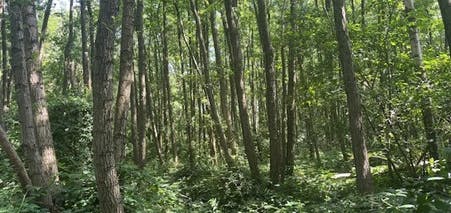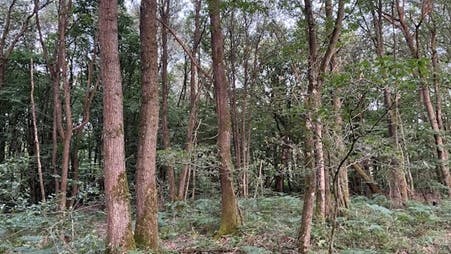
Great Priory Wood - prospective units BNG Proposed offset site
Local Planning Authority: Folkestone and Hythe
National Character Area(s): Wealden Greensand
Biodiversity Opportunity Area: Mid Kent Greensand & Gault
OS grid ref: TR 11033 38913
Postcode: TN26 6LA
What3words: ///tooth.slack.cold
Proposed Habitat units available
A total of 13.01 habitats units, 0.24 hedgerow units and 0.24 watercourse units are proposed from the following habitat types:
Grassland
Other neutral grassland (Medium distinctiveness) - 5.19 units
Heathland and Shrub
Mixed scrub (Medium distinctiveness) - 1.26 units
Woodland
Lowland mixed deciduous woodland (High distinctiveness) - 5.80 units
Ponds and Lakes
Ponds (priority habitat) (High distinctiveness) - 0.03 units
Wetlands
Reedbeds (High distinctiveness) - 0.68 units
Individual trees
Rural tree (Medium distinctiveness) - 0.08 units
Site description
Great Priory Wood extends to some 8 ha and is located approximately 6 km northwest of Hythe and just north of Sellindge in Kent.
Half of the site consists of ancient semi-natural woodland, meaning it has been continuously wooded for hundreds of years and has developed a unique species composition. Ancient woodlands are increasingly rare priority habitats in the UK, and many are in degraded condition due to lack of proper management.
The southern part of the site is a neutral grassland pasture, with a wet marshy area and dense scrub and reedbeds encroaching from the southernmost tip.
This open woodland edge grassland habitat provides ideal habitat for many bird, invertebrate, and reptile species, while the wetland provides breeding sites for flying insects which are favoured by swifts, swallows, and flycatchers.
Our proposals include enhancement of existing woodland to bring it to the best possible condition, while controlling scrub encroachment in the grassland and allowing the wetland to develop further into the landscape, by creating reedbeds and non-priority ponds and enhancing the other river and streams currently on site.
Species-rich native hedgerows will be planted on site and existing hedgerows will be enhanced to a better condition.
These BNG units are based on a desktop exercise. A full site survey would need to be undertaken to determine the current habitats on site to validate the current units/uplift.

Habitat Transitions


Site Photos





